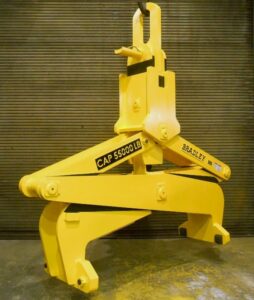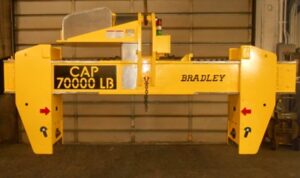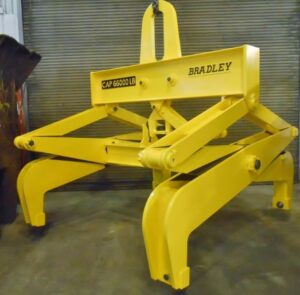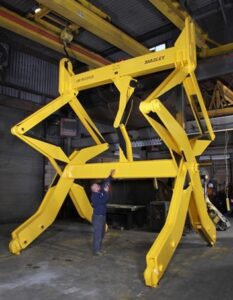Second only to safety, all Bradley Lifting equipment is manufactured with ruggedness and longevity in mind. Reliable performance in all environments is something we strive to provide, but what happens when the working environment is outside the realm of typical? Bradley will work to design a custom solution for you that will deliver consistent results through extreme temperatures, caustic environments, and other hazardous operating conditions.
Hard Loads
As loads climb up the scale of hardness issues can start to arise with the logistics of performing safe lifts. If possible, the ideal method of lifting high hardness loads would be though some method of non-penetration lifting. Cradling tongs are a great option as their design is simple and they do not require power or controls running to them.

If your load has geometry that is not well suited for cradling, penetrating the load to create grip is an excellent choice. These lifters shown below are equipped with replaceable hard tooled grip points.
|
|
Friction grip tongs are another option that can allow for a lift without needing penetration. Like the penetrating tongs, the contact points are replaceable, which increases the longevity of the lifter.

The biggest constraint with any sort of tong is their headroom and the operable range of loads. If a power supply is available, Bradley can provide electrically operated screw-type grabs as a solution. Screw grabs have an advantage over tong styled lifters as they user motor squeeze to provide initial penetration, with additional grip proportional to the weight of the load provided by mechanical wedge or cam motion.

|  |
Like the tong styled units mentioned earlier, the penetration points are replaceable. Regular inspection and maintenance are crucial for proper operation of these lifters, as worn-down grip points can lead to insufficient penetration and in worst case scenarios, dropped loads.
Extreme Temperatures
Often times casting facilities need to move billets/ingots before allowing them to cool to ambient temperatures. Bradley has engineered lifters that have handled loads over 2300°F (1260°C). Structural integrity and the protection of any electronic components are the main concerns when lifting loads this hot. Any lifters working with such loads must not have their structural members exceed 800°F (425°C) to prevent annealing the steel, resulting in a loss of strength. Generally, these hot application units also have thicker load bearing members to disperse more heat, allowing for longer lift times.

|  |
As shown in previous blog posts, Bradley has also provided lifters whose typical operating environment would involve being submerged in molten aluminum, fishing out fallen and broken anodes.

|  |
If a unit is operating in abnormal temperatures regulating measures may need to be put into place to ensure the unit operates as intended. The primary concern would be ensuring that a lifter with electrical components would be able to function reliably in these environments. Heat shielding or other forms of cooling can be provided in the electrical controls box to protect the circuitry from high temperatures. Likewise, if you have a lifter operating in a refrigerated area or outdoors during the winter, heaters could be mounted to prevent the circuits from getting too cold.
Caustic/Corrosive Environments
Although more of a niche case, there are lifting conditions where corrosion damage from some form of caustic agent is a prominent concern. Typically with these conditions 304 stainless steel is the material of choice. This type of stainless steel has excellent resistance to most types of chemicals and other forms of corrosive solutions. In cases where carbon steel components are used, special paint/coating systems can also be employed to help protect surfaces. This is especially useful for equipment exposed to salt air environments.
Magnetic Environments
A typically seen the potrooms of aluminum smelting facilities, the hundreds of kiloamps powering the electrolysis process generate large eddy currents which subsequently creates large magnetic fields. These magnetic fields can cause ferrous steel-constructed equipment to behave unexpectedly. The solution is to create lifters out of nonferrous, non-magnetic materials such as aluminum and stainless steel, which in lower capacity applications is an acceptable substitution for carbon steel. You can read more about potroom handling in our previous blog posts here.
In summary, there are many abnormal and extreme lifting conditions that may be present in your working environment. Bradley Lifting is here to work with you and provide custom engineered, reliable lifting solutions with whatever specifications you need for your project. If you have questions or are looking to know more about our custom solutions contact us here, our Applications Engineers will get back to you as soon as possible!


